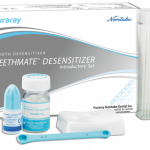For people with sensitive teeth, we have various treatment options depending on the severity, and we try to stay non-aggressive with treatments. To understand how the treatment works, one has to understand what causes the sensitivity, and from where it stems.

Sensitive Teeth Causes
Teeth are made of 3 different crystal structures called Hydroxyapatite, and the difference in them is how many pores are each contain. The outer crystal structure is Enamel, the inner is Dentin, and the root is made of Cementum. The root is embedded in the bone, which is covered by the gums. The cementum has no outer layer (enamel).
For people with gum disease, and for those who have recession of the gums and bone loss, they are now exposing the cementum layer, which is very porous. These pores in the cementum lead directly to the nerve of the tooth. Now we have an unprotected tooth structure that is very porous and anything that is hot or cold will be felt tremendously, causing extremely sensitive teeth.
For people who grind their teeth and now have very sensitive teeth, there are two areas that can be affected. The ground down areas have lost the protective enamel layer, and now expose the very porous dentin, which is in direct contact with the nerve causing extremely sensitive teeth. The other area that can be affected for Bruxism or Grinding patients is abrasion on the sides of the teeth (usually a V shaped indentation).

Desensitizer
Sensitive Teeth Treatments
Sensodyne is BAD for your teeth. Even the package insert on Sensodyne will tell you it is bad for your teeth. Sensodyne is simply sending a chemical inside your teeth through the pores that slowly kills the nerve of the tooth.
We have several topical desensitizing agents that can be applied at our office. The first is Gluma Desensitizer. This Gluma desensitizer can be placed under fillings, and on the topical surface where cementum or dentin is bare and unprotected. The Gluma desensitizer goes in the pores and seals them from hot and cold substances entering them. Usually the Gluma desensitizer is the first line of defense, and the least expensive. However, it can dissolve if something acidic (usually citrus juices or sodas) comes into contact. Gluma desensitizer is best to place under fillings.
Brand new on the market is Kuraray Teethmate Desensitizer. It works much like the Gluma Desensitizer, however, it does not dissolve as easily and it lasts longer. Using Teethmate Desensitizer by Kuraray we are actually making new Hydroxyapatite crystals on top of the bare cementum or dentin, creating a new layer of tooth structure on top of the pores or tubules stopping sensitivity from occurring. Teethmate desentizer needs to be mixed and placed by the dentist. Its great because its results are instantaneous. If the sensitivity doesn’t go away right away, the application can be repeated several times until the sensitivity goes away.

The next and best option is using MI paste in trays. We have seen amazing results that are long lasting and strengthen the teeth. MI paste should be used by everyone. MI paste contain Calcium and Phosphates that are extracted from milk, made into a paste. The calcium and phosphates are inserted into the teeth, helping to create stronger, less porous crystals that will seal off the tubules or pores so that hot and cold sensitivity is diminished. MI paste is made by GC dental products in Japan. The paste is put into trays made at our office, custom fit for your teeth and worn overnight, every night until the sensitivity goes away. It can take a while, up to a month or two. At that point, the trays should be worn two to three times a week as maintenance. The reason this is our favorite at lasting impressions dental is because this strengthens the teeth all around. It even strengthens old fillings, crowns, veneers, or any restoration because it helps recalcify the teeth.
Call (818) 751-5100








